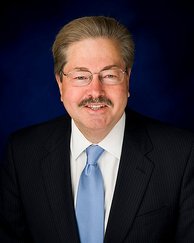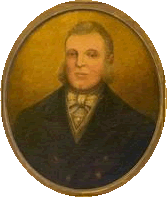The Five-Timers Club: Gubernatorial Edition
Thirty-seven governors in U.S. history were elected into office at least five times but only 10 served in the 20th or 21st Centuries; four members of the Club are alive today

Iowa’s Terry Branstad, meanwhile, joined the gubernatorial chapter of the Club when he was elected in November 2010 and is one of just four living members.
Overall, there are slightly more than three-dozen members of the Gubernatorial Five-Timers Club, and its membership took many different routes to get in.
Some did so in a consecutive series of 1-, 2-, or 3-year terms.
Some, like Branstad, did so in nonconsecutive terms – even though Iowa does not have term limits.
And some, in the late 18th and early 19th centuries did so without being elected by the public. (Various states, such as Georgia, Maryland, New Jersey, North Carolina, South Carolina, and Virginia, did not allow the direct election of governors via popular vote for years or decades, with state legislatures doing the honors instead).
In the coming months it will be determined whether veteran governors like Branstad, and other experienced but not-yet-in-the-Club governors like Rick Perry of Texas, John Kitzhaber of Oregon, and Jerry Brown of California will run for another term in 2014.
Kitzhaber already owns Oregon’s all-time record of being elected to the governor’s office three times (1994, 1998, 2010).
The thrice-elected Rick Perry is currently tied with Allan Shivers, M. Price Daniel, and John Connolly for the record in the Lone Star State as is Brown with former governor and Supreme Court Chief Justice Earl Warren in California.
But no new current governor is likely to join the Five-Timers Club, barring New Hampshire’s ex-Democratic Governor (and four times elected) John Lynch making a return bid in his state sometime down the road (in one of the two states, along with Vermont, which holds elections every two years).
And just how exclusive is the Gubernatorial Five-Timers Club?
A Smart Politics review of the election data of over 2,300 governors in U.S. history finds that just 37, or 1.6 percent, have been elected to the office at least five times, with just 10 who served in the 20th or 21st Centuries.
(Note: This analysis compiles a list of governors elected into office at least five times – whether by state legislature or popular vote – excluding terms served during pre-Constitutional period).
Aside from Branstad, the only other living members of the Club are fellow Hawkeye State Republican governor Robert Ray and Democrats Howard Dean of Vermont and Bill Clinton of Arkansas.
Branstad, who owns the record for the longest (non-colonial) gubernatorial service in the nation at 18 years and three months, is the only member of the Club who was elected exclusively to four-year terms.
The other nine members on the list elected since 1900 were victorious for gubernatorial terms in a combination of 1-, 2-, 3-, or 4-year stretches:
· Arizona Democrat George Hunt: 1 three-year term (1911) and 6 two-year terms (1914, 1916, 1922, 1924, 1926, 1930).
· Rhode Island Republican Aram Pothier: Four one-year terms (1908, 1909, 1910, 1911) and three two-year terms (1912, 1924, 1926).
· Michigan Democrat Soapy Williams: 6 two-year terms (1948, 1950, 1952, 1954, 1956, 1958).
· Arkansas Democrat Orval Faubus: 6 two-year terms (1954, 1956, 1958, 1960, 1962, 1964).
· Iowa Republican Robert Ray: 3 two-year terms (1968, 1970, 1972) and 2 four-year terms (1974, 1978).
· Arkansas Democrat Bill Clinton: 3 two-year terms (1978, 1982, 1984) and 2 four-year terms (1986, 1990).
· Vermont Republican Richard Snelling: 5 two-year terms (1976, 1978, 1980, 1982, 1990).
· Ohio Democrat Frank Lausche: 5 two-year terms (1944, 1948, 1950, 1952, 1954).
· Vermont Democrat Howard Dean: 5 two-year terms (1992, 1994, 1996, 1998, 2000).
Even more exclusive is the 10-Timers Club, which features a membership of just nine governors.
Each was a governor of a northeastern state and each was elected to a series of one-year terms in the late 18th and early 19th Centuries.

The “Father of Rhode Island” was first elected in 1790 and then reelected fifteen times through 1805.
Fenner served until his death later that year.
Shortly thereafter, Fenner’s son, James Fenner, was elected 13 times to the Ocean State, although not all in one stretch.
As a Jeffersonian Republican the younger Fenner was elected in 1807, 1808, 1809, 1810, 1824, 1825, 1826, 1827, 1828, and 1829.
He would win three more races as a Jacksonian Democrat in 1830 and under the Law and Order banner in 1843 and 1844.
Just ahead of the younger Fenner in second place is Federalist John Gilman who was elected 14 times in the State of New Hampshire.
Gilman won 11 consecutive one-year terms from 1794 through 1804.
After losing bids in 1805, 1806, 1808 and 1812, Gilman was elected again in 1813, 1814, and 1815.
Rounding out the 10-Timers Club for the most frequently elected governors in U.S. history are:
· New Jersey Jeffersonian-Republican Issac Williamson with 12: 1817, 1818, 1819, 1820, 1821, 1822, 1823, 1824, 1825, 1826, 1827, 1828.
· Connecticut Federalist Jonathan Trumbull, Jr. with 12: 1798, 1799, 1800, 1801, 1802, 1803, 1804, 1805, 1806, 1807, 1808, 1809.
· Massachusetts Federalist Caleb Strong with 11: 1800, 1801, 1802, 1803, 1804, 1805, 1806, 1812, 1813, 1814, 1815.
· Vermont Federalist Issac Tichenor with 11: 1797, 1798, 1799, 1800, 1801, 1802, 1803, 1804, 1805, 1806, 1808.
· Connecticut Jeffersonian-Republican Oliver Wolcott with 10: 1817, 1818, 1819, 1820, 1821, 1822, 1823, 1824, 1825, 1826.
· New Jersey Jeffersonian-Republican Joseph Bloomfield with 10: 1801, 1803, 1804, 1805, 1806, 1807, 1808, 1809, 1810, 1811.
One-year gubernatorial terms are now a relic of our nation’s past, running its course in the last northeastern states in the early 1900s.
The states with the most governors in the Five-Timers-Club are all northeastern states with Massachusetts, Vermont, Rhode Island, Connecticut, and New Jersey accounting for 25 of the 37 members:
Massachusetts with six: Federalist Caleb Strong (11), Jeffersonian-Republican Levi Lincoln, Jr. (9), Whig George Briggs (8), Federalist John Brooks (7), Republican John Andrew (5), and Federalist John Hancock (5). (Hancock also served as a colonial governor).
Vermont with six: Federalist Issac Tichenor (11), Jeffersonian-Republican Jonas Galusha (9), Thomas Chittenden (6), Whig Silas Jenison (5), Republican Richard Snelling (5), and Democrat Howard Dean (5). (Chittenden also served as a colonial governor).
Rhode Island with five: Anti-Federalist Arthur Fenner (16), Jeffersonian Republican/Jacksonian Democrat/Law and Order candidate James Fenner (13), Republican Aram Pothier (7), Federalist William Jones (6), and Democrat John Francis (5).
Connecticut with four: Federalist Jonathan Trumbull, Jr. (12), Jeffersonian-Republican Oliver Wolcott (10), Federalist Samuel Huntington (8), and Republican William Buckingham (8). (Huntington also served as a colonial governor).
New Jersey with four: Jeffersonian-Republican Isaac Williamson (12), Jeffersonian-Republican Joseph Bloomfield (10), Federalist Richard Howell (8), and Democrat Peter Vroom (6).
Membership of the Gubernatorial Five-Timers Club
|
Rank
|
State
|
Governor
|
Party
|
Years
|
#
|
|
1
|
RI
|
Arthur Fenner
|
Anti-Federalist (Country Party)
|
1790, 1791, 1792, 1793, 1794, 1795, 1796, 1797, 1798, 1799, 1800, 1801, 1802, 1803, 1804, 1805
|
16
|
|
2
|
NH
|
John Gilman
|
Federalist
|
1794, 1795, 1796, 1797, 1798, 1799, 1800, 1801, 1802, 1803, 1804, 1813, 1814, 1815
|
14
|
|
3
|
RI
|
James Fenner
|
Jeffersonian-Republican; Jacksonian Democrat, Law & Order
|
1807, 1808, 1809, 1810, 1824, 1825, 1826, 1827, 1828, 1829, 1830, 1843, 1844
|
13
|
|
4
|
NJ
|
Isaac Williamson
|
Jeffersonian-Republican
|
1817, 1818, 1819, 1820, 1821, 1822, 1823, 1824, 1825, 1826, 1827, 1828
|
12
|
|
4
|
CT
|
Jonathan Trumbull, Jr.
|
Federalist
|
1798, 1799, 1800, 1801, 1802, 1803, 1804, 1805, 1806, 1807, 1808, 1809
|
12
|
|
6
|
MA
|
Caleb Strong
|
Federalist
|
1800, 1801, 1802, 1803, 1804, 1805, 1806, 1812, 1813, 1814, 1815
|
11
|
|
6
|
VT
|
Issac Tichenor
|
Federalist
|
1797, 1798, 1799, 1800, 1801, 1802, 1803, 1804, 1805, 1806, 1808
|
11
|
|
8
|
CT
|
Oliver Wolcott
|
Jeffersonian-Republican
|
1817, 1818, 1819, 1820, 1821, 1822, 1823, 1824, 1825, 1826
|
10
|
|
8
|
NJ
|
Joseph Bloomfield
|
Jeffersonian-Republican
|
1801, 1803, 1804, 1805, 1806, 1807, 1808, 1809, 1810, 1811
|
10
|
|
10
|
MA
|
Levi Lincoln, Jr.
|
Jeffersonian-Republican
|
1825, 1826, 1827, 1828, 1829, 1830, 1831 (x2), 1832
|
9
|
|
10
|
VT
|
Jonas Galusha
|
Jeffersonian-Republican
|
1809, 1810, 1811, 1812, 1815, 1816, 1817, 1818, 1819
|
9
|
|
12
|
CT
|
William Buckingham
|
Republican
|
1858, 1859, 1860, 1861, 1862, 1863, 1864, 1865
|
8
|
|
12
|
MA
|
George Briggs
|
Whig
|
1843, 1844, 1845, 1846, 1847, 1848, 1849, 1850
|
8
|
|
12
|
NJ
|
Richard Howell
|
Federalist
|
1793, 1794, 1795, 1796, 1797, 1798, 1799, 1800
|
8
|
|
12
|
NH
|
John Langdon
|
Jeffersonian-Republican
|
1788, 1804, 1805, 1806, 1807, 1808, 1810, 1811
|
8
|
|
12
|
CT
|
Samuel Huntington
|
Federalist
|
1788, 1789, 1790, 1791, 1792, 1793, 1794, 1795
|
8
|
|
17
|
RI
|
Aram Pothier
|
Republican
|
1908, 1909, 1910, 1911, 1912, 1924, 1926
|
7
|
|
17
|
AZ
|
George Hunt
|
Democrat
|
1911, 1914, 1916, 1922, 1924, 1926, 1930
|
7
|
|
17
|
MA
|
John Brooks
|
Federalist
|
1816, 1817, 1818, 1819, 1820, 1821, 1822
|
7
|
|
20
|
AR
|
Orval Faubus
|
Democrat
|
1954, 1956, 1958, 1960, 1962, 1964
|
6
|
|
20
|
MI
|
Soapy Williams
|
Democrat
|
1948, 1950, 1952, 1954, 1956, 1958
|
6
|
|
20
|
TN
|
William Carroll
|
Jeffersonian-Republican, Democrat
|
1821, 1823, 1825, 1829, 1831, 1833
|
6
|
|
20
|
TN
|
John Sevier
|
Jeffersonian-Republican
|
1796, 1797, 1799, 1803, 1805, 1807
|
6
|
|
20
|
NJ
|
Peter Vroom
|
Democrat
|
1829, 1830, 1831, 1833, 1834, 1835
|
6
|
|
20
|
RI
|
William Jones
|
Federalist
|
1811, 1812, 1813, 1814, 1815, 1816
|
6
|
|
20
|
VT
|
Thomas Chittenden
|
n/a
|
1791, 1792, 1793, 1794, 1795, 1796
|
6
|
|
27
|
AR
|
Bill Clinton
|
Democrat
|
1978, 1982, 1984, 1986, 1990
|
5
|
|
27
|
IA
|
Robert Ray
|
Republican
|
1968, 1970, 1972, 1974, 1978
|
5
|
|
27
|
IA
|
Terry Branstad
|
Republican
|
1982, 1986, 1990, 1994, 2010
|
5
|
|
27
|
VT
|
Howard Dean
|
Democrat
|
1992, 1994, 1996, 1998, 2000
|
5
|
|
27
|
VT
|
Richard Snelling
|
Republican
|
1976, 1978, 1980, 1982, 1990
|
5
|
|
27
|
OH
|
Frank Lausche
|
Democrat
|
1944, 1948, 1950, 1952, 1954
|
5
|
|
27
|
MA
|
John Andrew
|
Republican
|
1860, 1861, 1862, 1863, 1864
|
5
|
|
27
|
VT
|
Silas Jenison
|
Whig
|
1836, 1837, 1838, 1839, 1840
|
5
|
|
27
|
RI
|
John Francis
|
Democrat
|
1833, 1834, 1835, 1836, 1837
|
5
|
|
27
|
ME
|
Albion Parris
|
Jeffersonian-Republican
|
1821, 1822, 1823, 1824, 1825
|
5
|
|
27
|
MA
|
John Hancock
|
Federalist
|
1789, 1790, 1791, 1792, 1793
|
5
|
Data compiled by Smart Politics with information culled from state election results and the National Governor’s Association biographical database.
Follow Smart Politics on Twitter.
